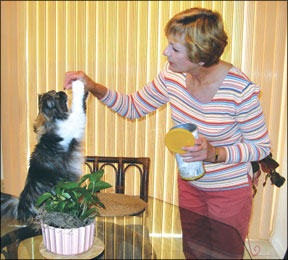A fine way to show your deserving cat that youre a wonderful human being is to give her a delicious treat now and then – a scrap of baked salmon, for example, or a tiny slice of chicken from your dinner plate. Or perhaps youll unwrap a new pack of its favorite commercial snack – a chewy chicken-flavored tidbit that you discovered on the shelves of your local grocery store.
This give-and-take interaction with your cat is perfectly all right, says Francis Kallfelz, DVM, a professor of veterinary nutrition at

Bev Caldwell
288
Cornell Universitys College of Veterinary Medicine, as long as you practice it in moderation and with appropriate vigilance. “The main reason that cat owners give treats is to enhance the human-animal bond,” he says, “and there is nothing inherently wrong with that. In fact, theres a good chance that offering treats now and then will make your cat more responsive to you.”
He points out, however, that any treat should be considered a component of a cats overall daily diet and that, of course, it should be a substance that is safe for feline ingestion. Also, he advises, “Be sure that your cat doesnt become so addicted to treats that it starts refusing to eat its regular food.”
Nutritional Suitability
Any treat, Dr. Kallfelz points out, should qualify as a component of a complete and balanced daily diet, preferably meeting standards published by the Association of American Feed Control Officials (AAFCO). Although the labels on all canned and dry commercial cat foods must carry a statement attesting to AAFCO approval, the same does not apply to products marketed as “treats” or “snacks.” Dr. Kallfelz prefers those treats that do carry a nutritional guarantee.
Most important, he notes, the caloric content of the treats must be subtracted from the total number of calories per day that the cat is supposed to consume, based on its age, desirable weight and overall health status. “The issue,” he says, “is not how frequently treats are given, but rather the calories that they contain. The total calories in the treats should not exceed 10 percent of an animals total recommended daily caloric intake.”
Treats can be given from time to time throughout the day, Dr. Kallfelz notes, as often as the owner is inclined to give them and the cat is inclined to take them. “But I think its probably best to give them a couple of hours after a meal,” he says. “If youre feeding the animal on a schedule and you notice that its bowl has remained full all day, its possible that youre giving too many treats.”
Snacking Options
Some treats are touted as being especially good for the promotion of a cats dental health. Dr. Kallfelz comments: “They may contain certain types of fiber that are reportedly advantageous because they have a scrubbing effect on the teeth when they are chewed.” As for snacks that are promoted as hairball preventives, he says: “These products contain ingredients that make it easier for ingested hairs to pass through the intestinal tract. Theoretically, they should be helpful, but results may be variable.” Table scraps are all right, Dr. Kallfelz notes, as long as they arent too fatty. “A tiny bit of fat is okay,” he says, “but fat, of course, is high in calories and the risk of obesity will rise in a cat that eats too much of it.”
Some foods should never be offered as a treat, he warns. Grapes, raisins and chocolate, for example, contain substances that are toxic to cats. And onions and garlic contain substances that can damage a cats red blood cells. With regard to dairy products, Dr. Kallfelz says: “Yogurt is certainly okay as a snack because it is already fermented. As for milk, a cat may be able to tolerate it very well, and there will be no problem. But many cats lack the enzymes necessary to digest it. You can try it, but if your cat gets diarrhea, you certainly shouldnt continue.”

